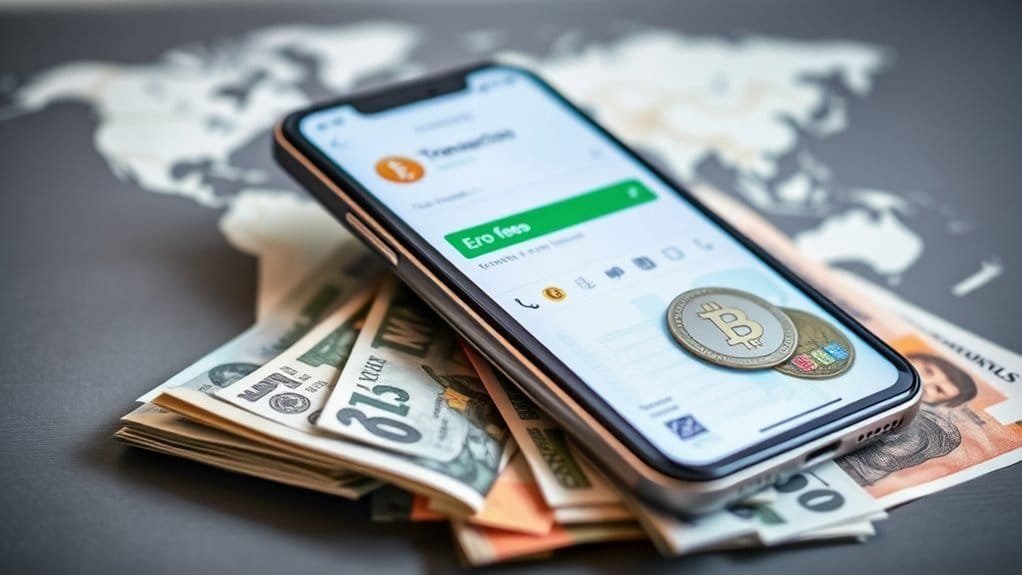Cost Savings of crypto payments start with cutting transaction fees, often as low as 0.5%, compared to 2%-3% for credit cards. You avoid high cross-border fees, which can exceed 10%, and benefit from near-zero costs with cryptocurrencies like Stellar or Ripple. By eliminating intermediaries like banks, you reduce processing fees and streamline payments.
Businesses can save thousands annually, with e-commerce retailers saving up to $30,000. Transactions settle in real-time, improving cash flow and reducing delays. Blockchain technology also improves security and transparency, minimizing fraud. If you’re curious about how these savings can impact your finances, there’s more to investigate.
What You Will Learn
- Crypto payments reduce transaction fees to as low as 0.5%, compared to 2%-3% for credit cards.
- Businesses save on international payments by bypassing traditional fees exceeding 6%.
- Eliminating intermediaries like banks lowers processing costs and simplifies payment infrastructure.
- Cross-border transactions with crypto avoid high fees, often exceeding 10% with traditional methods.
- Automated blockchain workflows minimize manual errors and improve cash flow with real-time settlements.
Reduced Fees Start Cost Savings of Crypto Payments

With regard to payment methods, cryptocurrencies stand out by offering significantly reduced transaction fees compared to traditional systems. When I use PayPal, I’m charged close to 4% per transaction, plus setup fees. In contrast, some Bitcoin exchanges charge under 1%, and the average Bitcoin transaction fee is now $2.809, down from $13.68 a year ago. That’s a 79.47% reduction, which makes a big difference for me, especially when I’m sending money internationally.
Cryptocurrencies like Nano, Stellar, and Ripple take this even further. Nano offers near-zero fees, Stellar charges about $0.00001 per transaction, and Ripple’s fee is around $0.0002. These low fees are possible because blockchain technology eliminates intermediaries, streamlining the process.
For businesses, this means significant cost savings and a competitive edge. Global retailers, for example, can process high-volume transactions at minimal fees, passing those savings on to customers like you.
I find this particularly appealing because it’s not just about saving money—it’s about efficiency and security. With cryptocurrencies, I know my transactions are handled quickly and securely, without the extra costs of traditional systems.
Lower Processing Costs
Cryptocurrencies’ lower processing costs stem from their ability to cut out intermediaries like banks and credit card companies. When you use crypto payments, you bypass these traditional gatekeepers, which often charge hefty fees for their services.
Instead, blockchain technology handles the transaction directly, reducing the need for manual clearing and settlement processes. This automation not only speeds up transactions but also minimizes errors, saving you time and money.
Here’s how crypto payments keep processing costs low:
- No third-party fees: Without banks or credit card companies involved, you avoid their transaction fees, which can add up quickly.
- Automated systems: Blockchain technology streamlines processes, reducing the need for manual intervention and cutting operational costs.
- Simplified infrastructure: Crypto payments don’t require physical terminals or equipment, so you save on maintenance and setup costs.
For example, companies like BitPay offer straightforward pricing, such as 1-2% + 25¢ per transaction, making it easier to manage expenses.
The digital nature of crypto payments also means less administrative burden and simplified reporting. By leveraging these efficiencies, you can focus on growing your business without worrying about unnecessary processing costs.
No Cross-Border Fees

Eliminating cross-border fees is one of the most persuasive advantages of using cryptocurrency for international payments. When I send money abroad with traditional methods, I often face high fees—sometimes up to 10% of the total amount. With crypto, I avoid these costs entirely.
Blockchain technology allows me to send funds directly to the recipient without intermediaries like banks or payment processors. This peer-to-peer system guarantees that my money moves faster and more securely.
Crypto transactions can cost as little as $0.00005, a fraction of what traditional services charge. I also appreciate the 24/7 availability, which means I don’t have to wait for small business hours to complete a transfer.
While volatility can affect costs, crypto generally remains a more affordable option. Furthermore, features like smart contracts and decentralized ledgers improve security, reducing the risk of fraud or errors.
As adoption grows, I see cryptocurrencies becoming even more efficient for cross-border payments. Innovations like the Lightning Network are already reducing fees and improving scalability for entrepreneurs.
For anyone looking to save on international transfers, crypto offers a safe, cost-effective solution.
Streamlined Payment Processes
Streamlining payment processes with cryptocurrency has changed how I handle transactions, making them faster and more efficient. By using crypto, I’ve eliminated many of the delays and inefficiencies that come with traditional payment methods. Transactions settle in real-time, which means I don’t have to wait days for funds to clear. This speed improves my cash flow and reduces the risk of late payments.
Furthermore, the automation features built into crypto systems cut down on manual work, saving me time and effort.
Here’s how crypto simplifies payment processes for me:
- Real-time transactions: Payments are processed instantly, so I don’t deal with waiting periods.
- Automated workflows: Invoicing and collections are handled automatically, reducing errors.
- Enhanced security: Blockchain technology guarantees transactions are secure and transparent.
The integration of crypto with existing systems also makes management easier. I can track payments in real-time and access detailed records without sifting through paperwork.
This level of efficiency not only saves me money but also gives me peace of mind knowing my transactions are secure and reliable.
Direct Payment Transfers

Efficiency in financial transactions has always been a priority for me, and direct payment transfers with cryptocurrency have proven to be a revolutionary development.
When I use crypto for direct payments, I avoid the high fees associated with traditional banking intermediaries. Bank transfer fees are often lower, and platforms like Binance make large transactions more cost-effective. Additionally, selecting the correct fiat currency ensures that the recipient avoids unnecessary conversion fees.
The speed of these transactions is another advantage. Direct crypto payments are completed in minutes, while traditional methods can take days due to intermediaries. Network congestion can slow things down, but it’s still faster than waiting for banks to process transfers.
Security is a major concern for me, and crypto payments address this by eliminating intermediaries. Digital signatures guarantee secure transactions without relying on trusted third parties. Traditional methods, which depend on central parties, are more vulnerable to fraud.
Global accessibility is another benefit. I can send funds in multiple fiat currencies to over 190 countries without geographical restrictions. Platforms like Kraken support SEPA and SWIFT transfers, making international transactions seamless.
Direct payment transfers with crypto offer lower fees, faster speeds, improved security, and global reach, making them a reliable choice for safe and efficient transactions.
Real-World Cost Savings
By leveraging cryptocurrency payments, I’ve seen directly how businesses and individuals can achieve substantial cost savings in real-world scenarios.
For example, an e-commerce retailer processing $500,000 in sales saved $30,000 annually by switching from traditional payment methods to crypto. Freelance platforms also benefit, eliminating intermediaries and reducing disputes, which improves efficiency and user satisfaction.
International remittances see significant savings too, with crypto bypassing traditional fees that often exceed 6% of the transaction amount.
Here are three key ways crypto payments deliver real-world cost savings:
- Lower Transaction Fees: Crypto fees can be as low as 0.5%, compared to 2%-3% for credit cards.
- Elimination of Intermediaries: Direct transfers reduce processing costs and speed up settlements.
- Global Accessibility: Crypto enables seamless cross-border transactions without hefty currency exchange fees.
These savings aren’t just theoretical—they’re measurable and impactful.
Businesses reinvest the extra funds into growth, while individuals enjoy faster, cheaper transactions. If you’re looking for a secure way to reduce costs, crypto payments offer a proven solution.
Blockchain Efficiency Benefits

Exploring blockchain’s efficiency advantages reveals how it alters traditional systems. Blockchain improves security through immutable records, guaranteeing data can’t be altered once added. Its decentralized and cryptographic nature resists tampering and unauthorized access, reducing fraud and risk. Smart contracts automate agreements, minimizing human intervention and improving security. Decentralized control gives users direct management of their data, enhancing safety.
Blockchain also increases transparency. Transactions are traceable in real time, allowing easy verification and accountability. You can choose public ledgers for openness or private ones for controlled access. All parties access the same information, reducing delays. Smart contracts provide clear, automated terms, guaranteeing transparency in execution. In supply chains, blockchain fosters trust and sustainable practices.
Efficiency rises with blockchain. It streamlines processes by cutting intermediaries, speeding up transactions, and lowering costs. Smart contracts execute automatically, reducing manual work and errors. Faster transactions and scalability improvements, like adjusting block size, uplift network efficiency.
Blockchain’s adaptability supports sustainability. Energy-efficient mechanisms, like Proof of Stake, reduce environmental impact. It elevates industry productivity by up to 9% and cuts inefficiencies in sectors like construction. Blockchain guarantees safer, transparent, and efficient systems.
Frequently Asked Questions
How Do Crypto Payments Impact Tax Reporting?
Crypto payments complicate my tax reporting because they’re treated as property, not currency. I must track fair market value at receipt and report transactions as income or capital gains, often needing detailed records and tax software.
Are Crypto Payments Secure Against Hacking?
Crypto payments are like a fortress with layers of defense. I rely on blockchain’s consensus mechanisms, encryption, and multi-factor authentication to shield my transactions. Regular updates and audits guarantee my assets stay secure against hacking threats.
Can Crypto Payments Be Reversed if Needed?
I can’t reverse crypto payments once they’re sent because blockchain transactions are permanent. I always double-check details and verify addresses to avoid mistakes. Unlike credit cards, there’s no chargeback option, so I’m extra careful.
What Happens if Crypto Prices Fluctuate During a Transaction?
I’ve seen crypto prices swing by over 10% in minutes during transactions. If that happens, I might end up paying more or receiving less than expected. It’s why I always monitor market volatility closely before confirming.
How Do Businesses Handle Crypto-To-Fiat Conversions?
I handle crypto-to-fiat conversions by using third-party vendors or payment gateways to keep crypto off my balance sheet. I focus on secure platforms with low fees and guarantee compliance with tax and regulatory requirements.
Get Started With Crypto Payments Today
By switching to crypto payments, you save on transaction fees, often under 1%, compared to traditional methods. Processing costs drop since there’s no middleman, and cross-border fees vanish entirely.
Payments become faster, direct, and streamlined, cutting unnecessary steps. Blockchain’s efficiency guarantees secure, low-cost transfers. Real-world examples show businesses saving thousands annually. It’s a smarter, simpler way to handle money, offering tangible benefits without the usual financial headaches.

